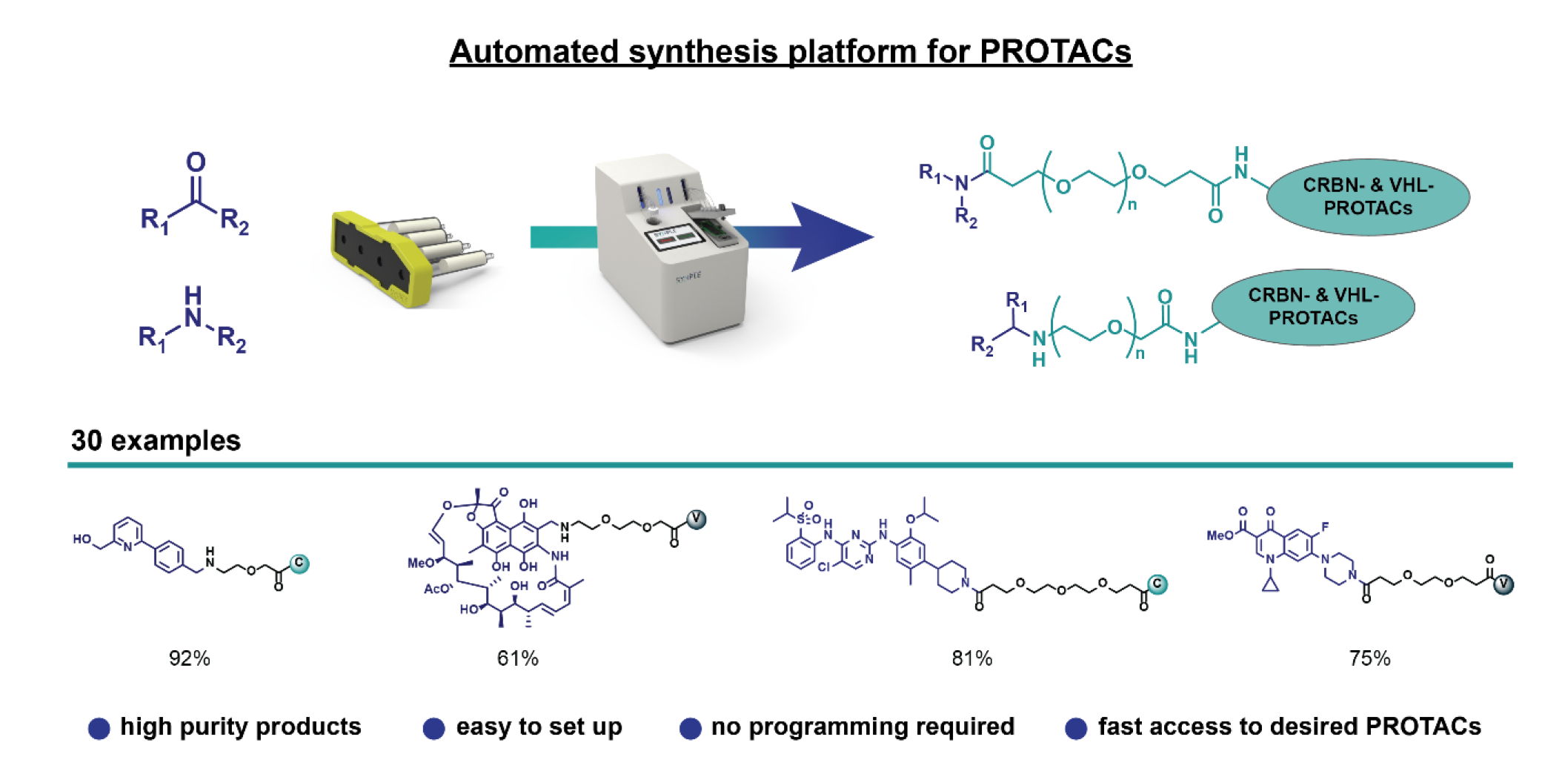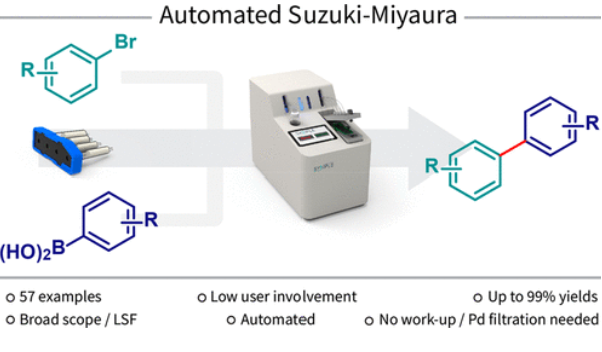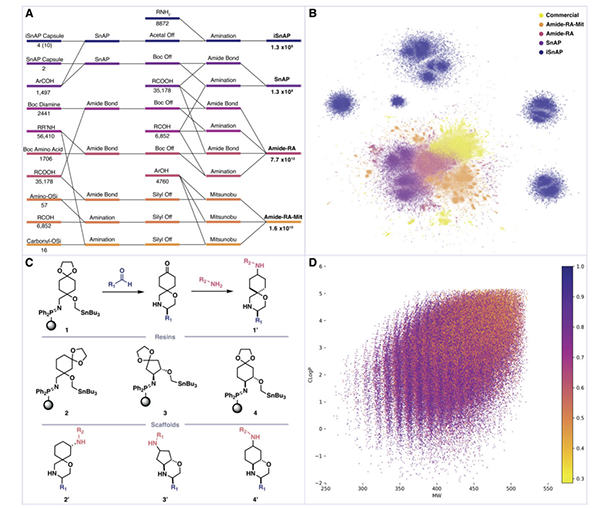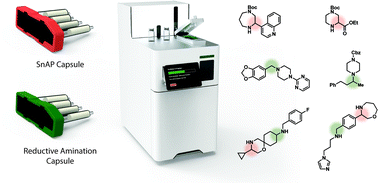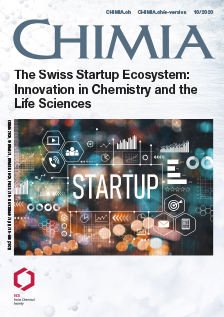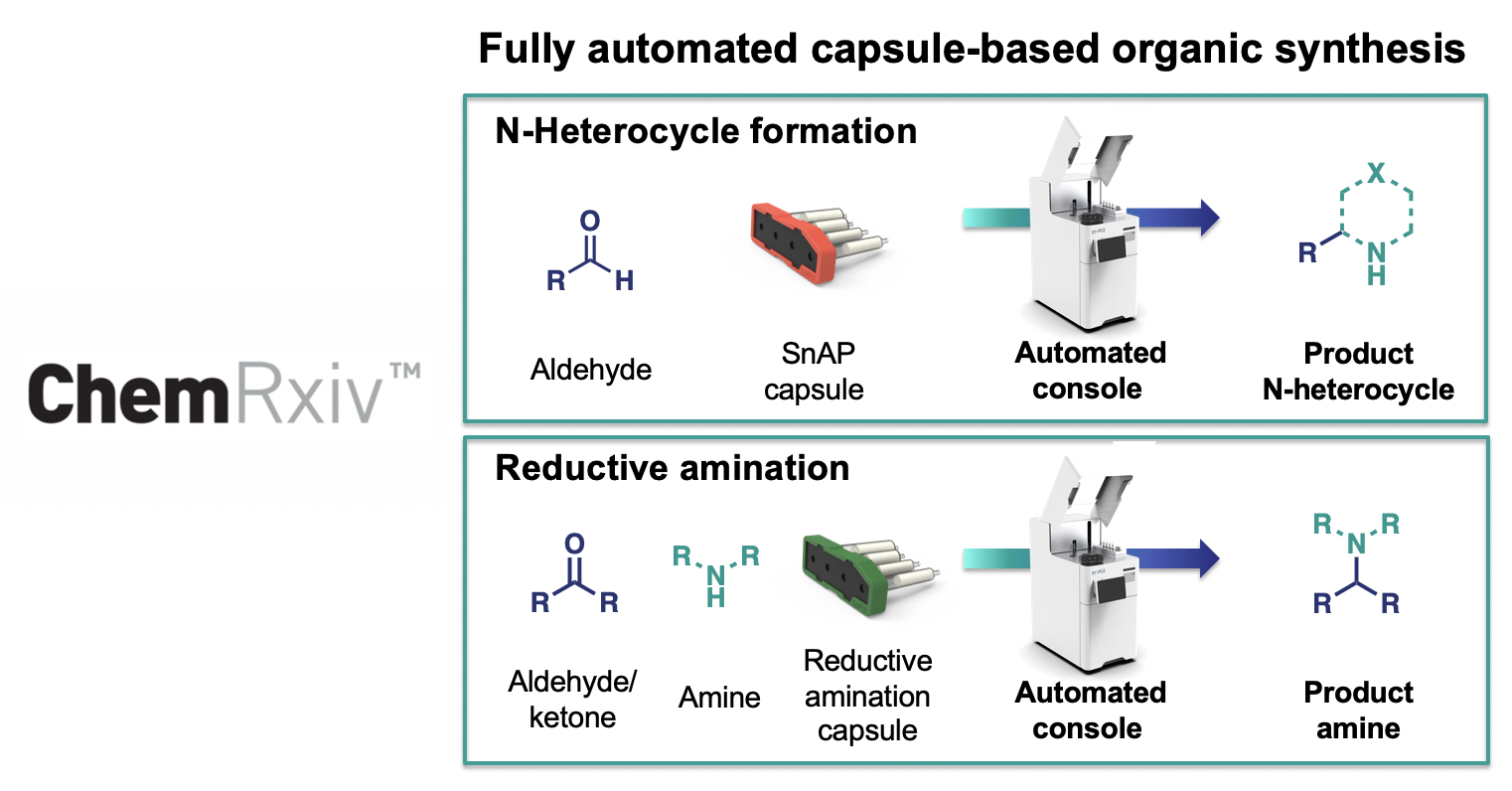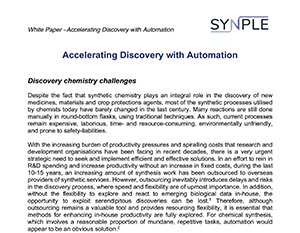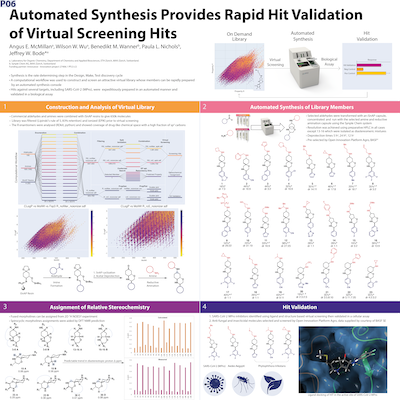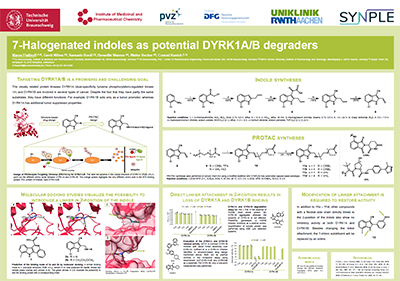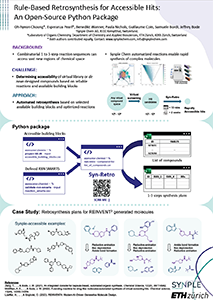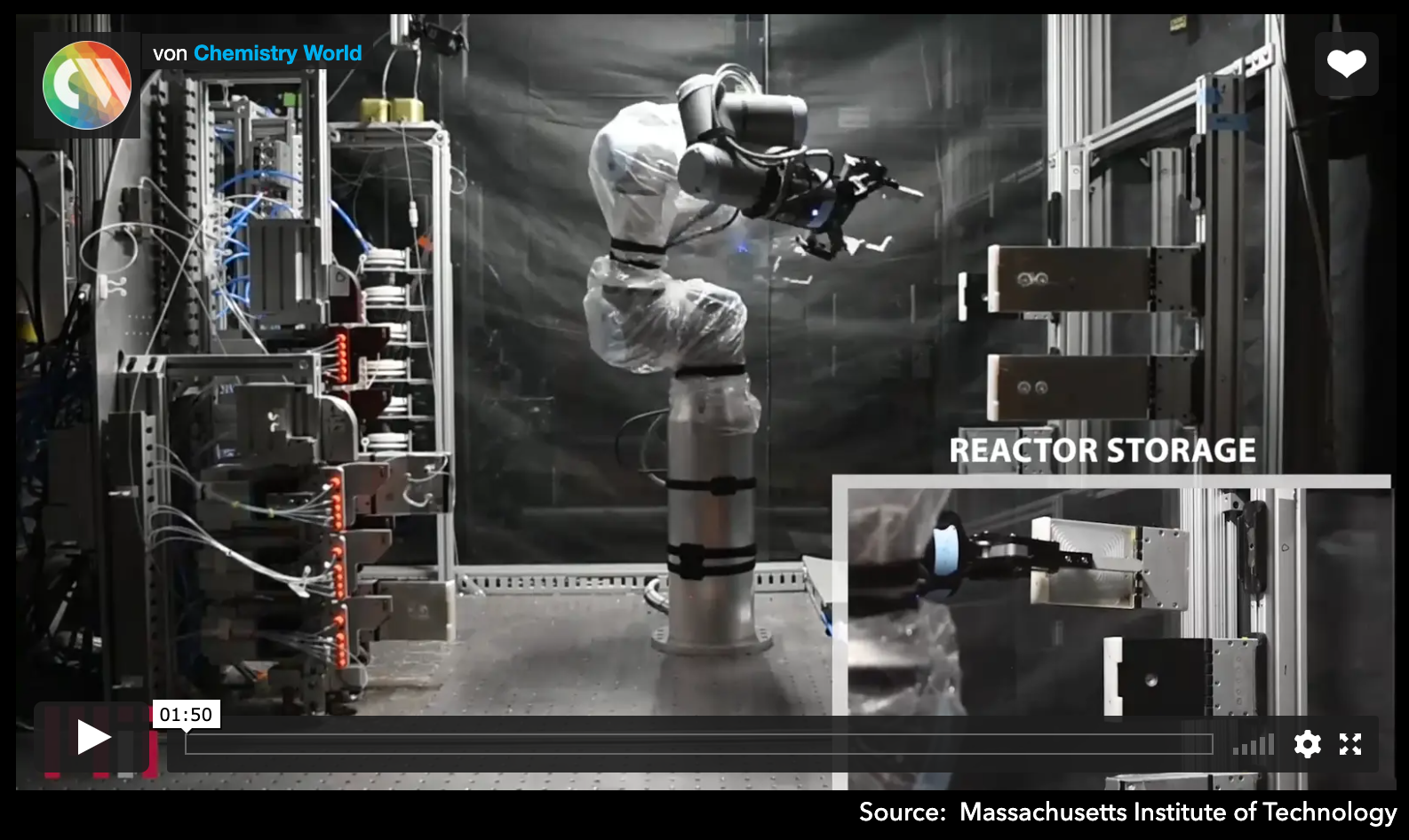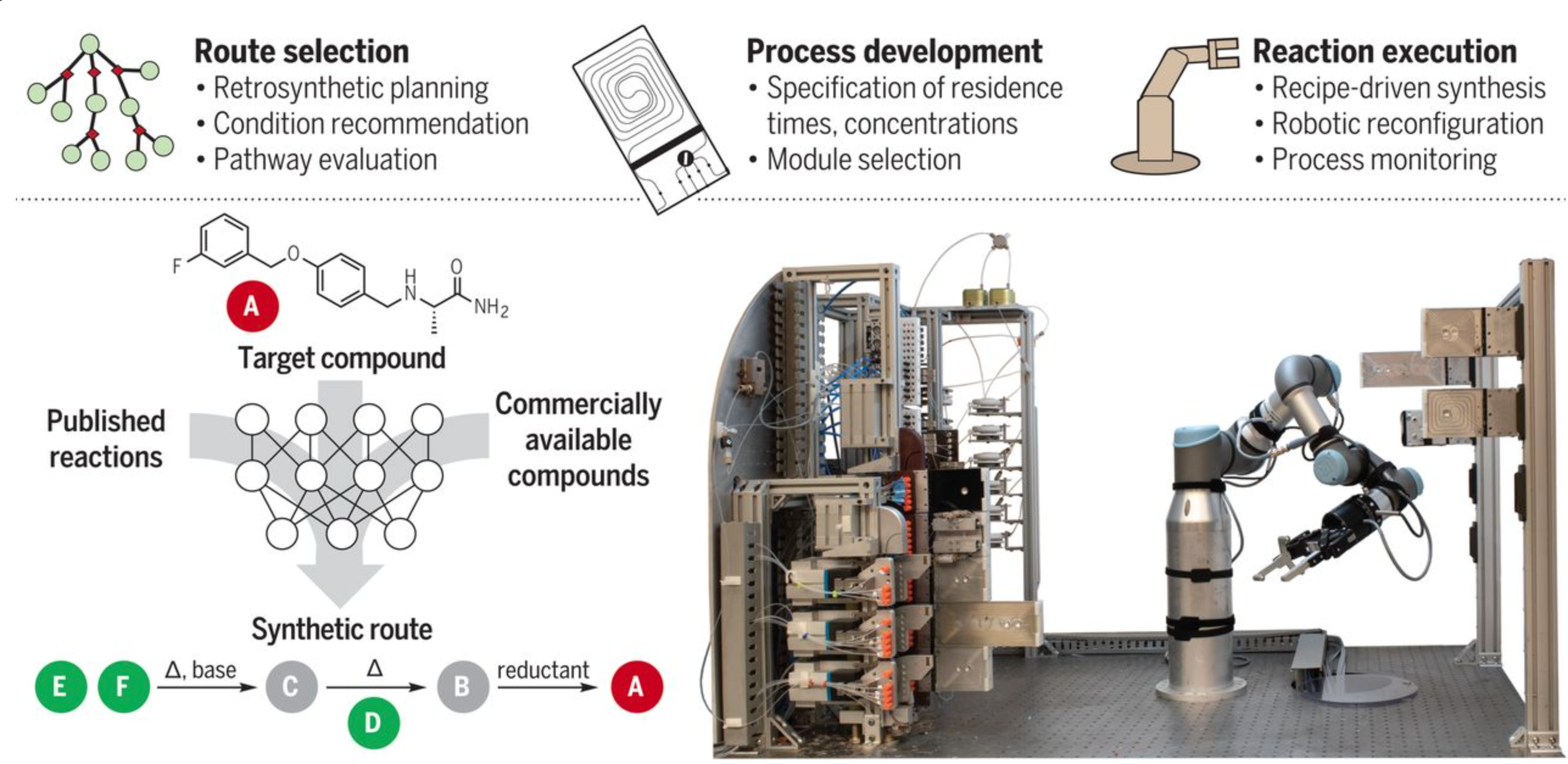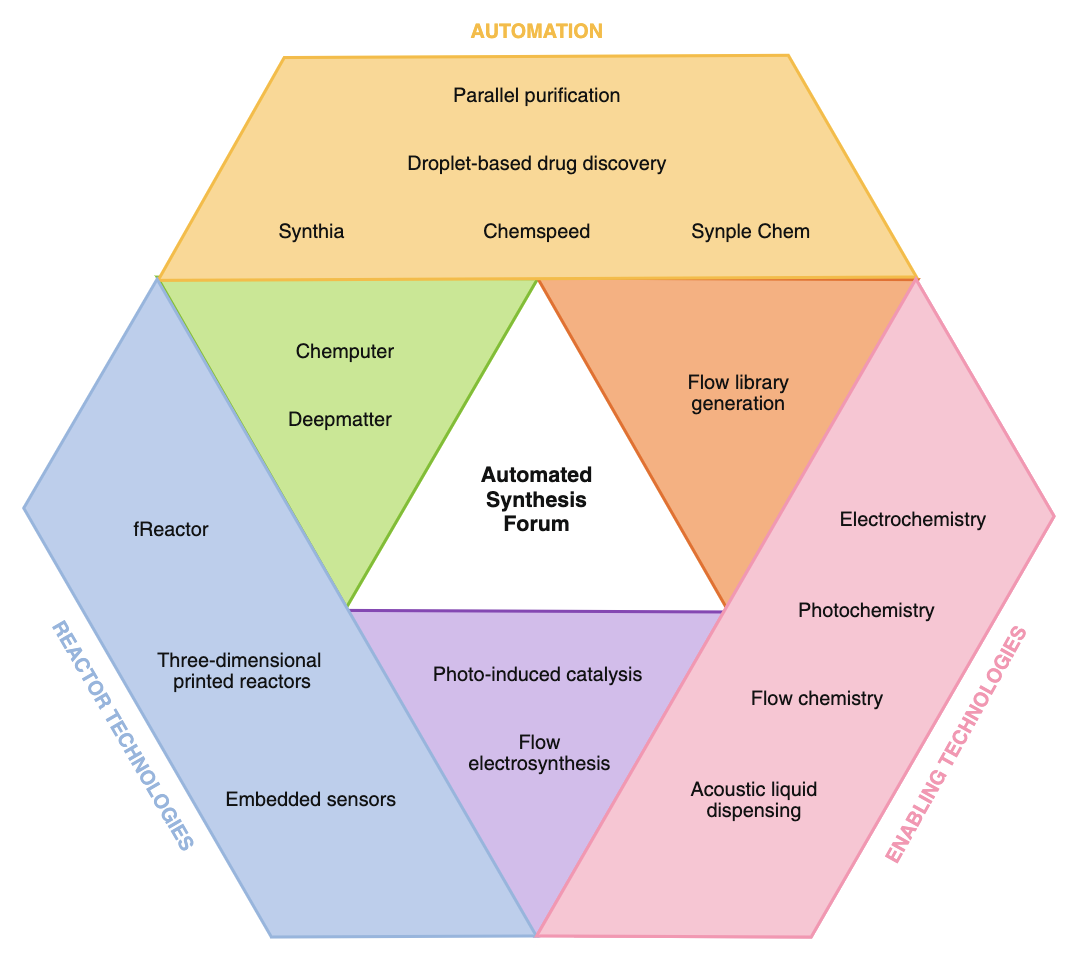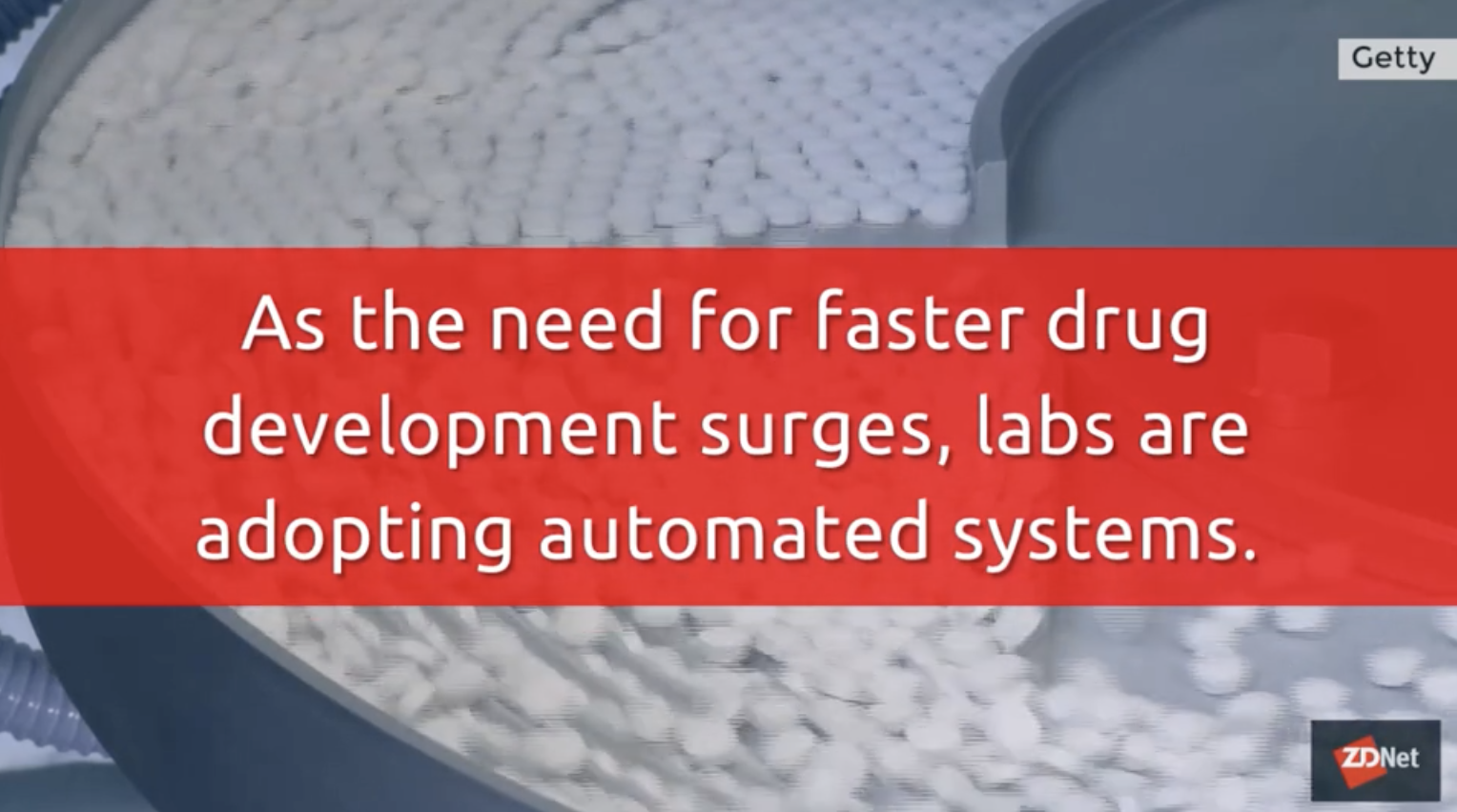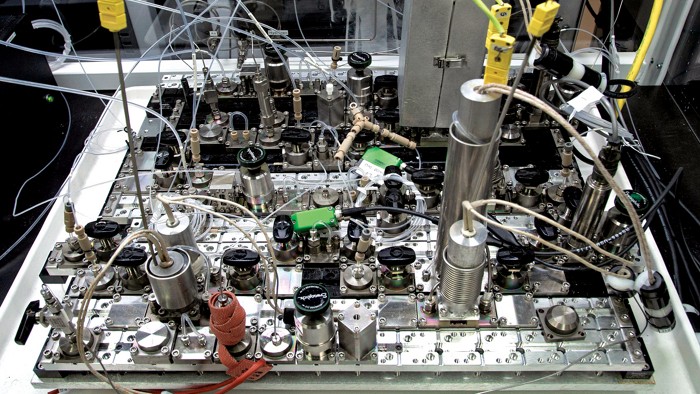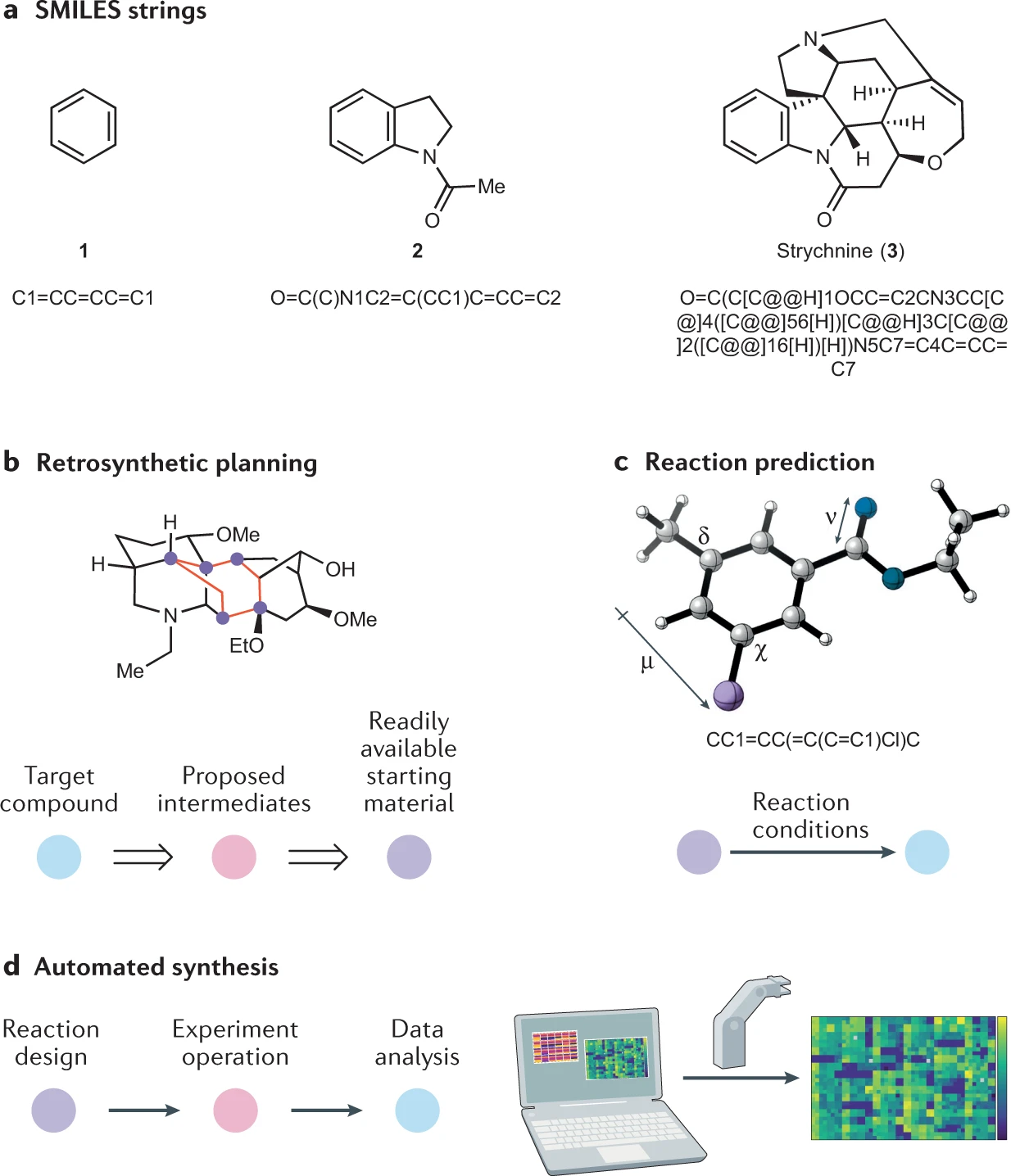Literature
Publication using the Synple platform
Automated and Parallel Amide Synthesis
Source: European Journal of Organic Chemistry
Author: Tuo Jiang, Guillaume Coin, Samuele Bordi, Benedikt Wanner
This study presents a streamlined, automated method for synthesizing amide-containing compounds, crucial in pharmaceuticals and agrochemicals. Utilizing pre-packed capsules and 96-well plate kits, this user-friendly approach simplifies the reaction and isolation processes, accommodating diverse reactants. This work allows to enhance medicinal chemistry by accelerating the creation of compound libraries with high efficiency and yield.
continue here...
Capsules for Automated Azide–Alkyne Click Reactions
Source: Organic Letters
Author: Jeffrey Bode et al.
The development of an automated and reproducible process for copper-mediated click reactions of alkynes and azides into 1,4-disubstituted 1,2,3-triazole products is described. This method utilizes prepacked capsules that contain all necessary reagents and materials for the reaction and purification processes. The reaction and product isolation steps are fully automated with no further user involvement, resulting in the triazole products in high purity. The effectiveness of capsule-based automated organic synthesis was further demonstrated by sequencing the automated synthesis of organic azides, followed by a second capsule for CuAAC with no intermediate purification.
continue here...
Automated Synthesis for the Safe Production of Organic Azides from Primary Amines
Source: Organic Letters
Author: Tuo Jiang, Guillaume Coin, Benedikt Wanner
Described herein is the development of an automated and reproducible process for the conversion of primary amines to organic azides utilizing prepacked capsules containing all the required reagents, including imidazole-1-sulfonyl azide tetrafluoroborate. Apart from manually loading the primary amine into the reaction vessel, the entire reaction and product isolation process can be achieved automatically, with no further user involvement, and delivers the desired organic azide in high purity. This practical and simple automated capsule-based method offers a convenient and safe way of generating organic azides without handling or exposure of potentially explosive reagents.
continue here...
Capsule-based automated synthesis for the efficient assembly of PROTAC like molecules
Source: RSC Digital Discovery
Author: Samuele Bordi, Benedikt Wanner
As a result of high false positive rates in virtual screening campaigns, prospective hits must be synthesised for validation. When done manually, this is a time consuming and laborious process. Large “on-demand’ virtual libraries ( > 7 x 1012 members), suitable for preparation using capsule-based automated synthesis and commercial building blocks, were evaluated to determine their structural novelty.
continue here...
Automated, Capsule-Based Suzuki–Miyaura Cross Couplings
Source: Organic Letters
Author: Guillaume Coin, Benedikt Wanner
The development of an automated process for Suzuki–Miyaura cross couplings is described, in which the complete reaction, workup, and product isolation are effected automatically with no user involvement, aside from loading of the starting materials and reaction capsule. This practical and simple method was successfully demonstrated to provide the desired biaryl products using a range of aryl bromides and boronic acids and is also effective for the late-stage functionalization of aryl halides in bioactive molecules.
continue here...
A Vending Machine for Drug-like Molecules – Automated Synthesis of Virtual Screening Hits
Source: ChemRxiv
Author: Angus E. McMillan, Jeffrey Bode
As a result of high false positive rates in virtual screening campaigns, prospective hits must be synthesised for validation. When done manually, this is a time consuming and laborious process. Large “on-demand’ virtual libraries ( > 7 x 1012 members), suitable for preparation using capsule-based automated synthesis and commercial building blocks, were evaluated to determine their structural novelty.
continue here...
An integrated console for capsule-based, automated organic synthesis
Source: Chemical Science
Author: Jeffrey Bode et al.
The current laboratory-based practice of organic synthesis renders automation difficult, suffers from safety and environmental hazards, and hampers the implementation of artificial intelligence guided drug discovery. Using a combination of innovative reagent design, hardware engineering, and a simple operating system we provide an instrument capable of executing complex organic reactions with prepacked capsules in a fully automated fashion. The machine conducts coupling reactions and delivers the purified products with minimal user involvement.
continue here...
Cartridge-based Automated Synthesis – A New Tool for the Synthetic Chemist
Source: Chimia
Author: Synple Chem, Wanner, Nichols, Jiang
Despite recent advances in reaction methodologies, organic synthesis remains complex and challenging. Many of the fundamental processes in use have not changed in over 100 years, with a large proportion of the work being carried out manually, using lengthy procedures and difficult or hazardous reaction conditions. As such, organic synthesis still presents a bottle-neck in discovery research.
continue here...
An Integrated Console for Capsule-Based, Fully Automated Organic Synthesis
Source: ChemRxiv
Author: Jeffrey Bode et al.
The current laboratory-based practice of organic synthesis renders automation difficult, suffers from safety and environmental hazards, and hampers the implementation of artificial intelligence guided drug discovery. Using a combination of innovative reagent design, hardware engineering, and a simple operating system we provide an instrument capable of executing complex organic reactions with prepacked capsules in a fully automated fashion. The machine conducts coupling reactions and delivers the purified products with minimal user involvement.
continue here...
Accelerating Discovery with Automation
Source: Synple Chem
Author: Synple Chem Team
Despite the fact that synthetic chemistry plays an integral role in the discovery of new medicines, materials and crop protections agents, most of the synthetic processes utilised by chemists today have barely changed in the last century. Many reactions are still done manually in round-bottom flasks, using traditional techniques. As such, current processes remain expensive, laborious, time- and resource-consuming, environmentally unfriendly, and prone to safety-liabilities.
continue here...
Posters using the Synple platform
Automated Synthesis Provides Rapid Hit Validation of Virtual Screening Hits
Source: Presented at Synthesis in Drug Discovery and Development Conference 2021 (UK)
Author: Angus E. McMillan
Download here
7-Halogenated indoles as potential DYRK1A/B degraders
Source: Poster presented at ACS Chicago fall 2022
Author: Maren Flasshoff, Conrad Kunick
Download here
Rule-Based Retrosynthesis for Accessible Hits: An Open-Source Python Package
Source: Presented at the Automated Synthesis Forum, Basel 2023
Author: Oh-hyeon Choung
Download here
Our top reading picks in the area of chemistry automations
Automated Chemical Synthesis: Still a Long Way Off or on the Brink?
Source: Charles River - Eureka
Author: Robert Chapman
Some early approaches offer a window on the thrilling potential and important strides that chemical labs are making.
We seem to be at the start of an automated system revolution. Several industries are moving to automation as a way to reduce costs, increase efficiencies, and in some cases improve safety. From self-driving cars to drone deliveries of your online shopping, odds are we will all be exposed to some level of automation in our lives. Can chemical synthesis join in and move towards automated chemical synthesis, or will we be left behind?
continue here...
Are synthetic chemists out of a job as AI meets automation?
Source: Chemistry World
Author: Philip Ball
There’s nothing like the automation of chemical synthesis to get chemists worried. Could robots and artificial intelligence (AI) one day replace them, just as they seem to threaten so many other activities and jobs? A project led by a team at the Massachusetts Institute of Technology (MIT) seems now to imply that the answer could be yes – and no.
continue here...
Cartridge-based Automated Synthesis – A New Tool for the Synthetic Chemist
Source: Chimia
Author: Synple Chem, Wanner, Nichols, Jiang
Despite recent advances in reaction methodologies, organic synthesis remains complex and challenging. Many of the fundamental processes in use have not changed in over 100 years, with a large proportion of the work being carried out manually, using lengthy procedures and difficult or hazardous reaction conditions. As such, organic synthesis still presents a bottle-neck in discovery research.
continue here...
A robotic platform for flow synthesis of organic compounds informed by AI planning
Source: Science
Author: Klavs F. Jensen et al.
Progress in automated synthesis of organic compounds has been proceeding along parallel tracks. One goal is algorithmic prediction of viable routes to a desired compound; the other is implementation of a known reaction sequence on a platform that needs little to no human intervention. Coley et al. now report preliminary integration of these two protocols. They paired a retrosynthesis prediction algorithm with a robotically reconfigurable flow apparatus. Human intervention was still required to supplement the predictor with practical considerations such as solvent choice and precise stoichiometry, although predictions should improve as accessible data accumulate for training.
continue here...
The Medicinal Chemistry in the Era of Machines and Automation: Recent Advances in Continuous Flow Technology
Source: Journal of Medicinal Chemistry
Author: Antimo Gioiello et al.
Medicinal chemistry plays a fundamental and underlying role in chemical biology, pharmacology, and medicine to discover safe and efficacious drugs. Small molecule medicinal chemistry relies on iterative learning cycles composed of compound design, synthesis, testing, and data analysis to provide new chemical probes and lead compounds for novel and druggable targets. Using traditional approaches, the time from hypothesis to obtaining the results can be protracted, thus limiting the number of compounds that can be advanced into clinical studies.
continue here...
Meeting Report Automated Synthesis Forum 2020 - Minimal manual input
Source: Nature Chemistry
Author: David M. Heard, Alastair J. J. Lennox
Synthetic organic chemistry is increasingly automated, data rich and intelligent. At the Automated Synthesis Forum, industry and academia showcased their recent progress towards this augmented future.
The field of synthetic organic chemistry continuously evolves as new technologies are integrated into the lab, for example, the rise in popularity of liquid chromatography–mass spectrometry, automated flash chromatography, digital lab notebooks, online databases and retrosynthesis platforms. These innovations have improved efficiency and productivity, thus facilitating the rate of development and frequency of new discoveries.
continue here...
An Integrated Console for Capsule-Based, Fully Automated Organic Synthesis
Source: ChemRxiv
Author: Jeffrey Bode et al.
The current laboratory-based practice of organic synthesis renders automation difficult, suffers from safety and environmental hazards, and hampers the implementation of artificial intelligence guided drug discovery. Using a combination of innovative reagent design, hardware engineering, and a simple operating system we provide an instrument capable of executing complex organic reactions with prepacked capsules in a fully automated fashion. The machine conducts coupling reactions and delivers the purified products with minimal user involvement.
continue here...
Chemists: AI Is Here; Unite To Get the Benefits
Source: Journal of Medicinal Chemistry
Author: Edward J. Griffen
The latest developments in artificial intelligence (AI) have arrived into an existing state of creative tension between computational and medicinal chemists. At their most productive, medicinal and computational chemists have made significant progress in delivering new therapeutic agents into the clinic. However, the relationship between these communities has the prospect of being weakened by application of oversimplistic AI methods that, if they fail to deliver, will reinforce unproductive prejudices. We review what can be learned from our history of integrating QSAR and structure-based methods into drug discovery.
continue here...
In the Pipeline: Robo-Chemist: The Latest Version
Source: In the Pipeline
Author: Derek Lowe
So let’s talk robotic chemistry experimentation – that always calms everyone right down, doesn’t it? This new paper in Nature from a group in Liverpool is (at heart) a pretty straightforward implementation of modern reaction optimization, with the added feature that it’s being done by a mobile robot, rolling around the lab in the dark for about 20 hours a day. The motorized chemist itself is shown at right – it’s battery operated (the four hours per day of down time is for charging) and can perform a wide variety of tasks and manipulations on both solid and liquid samples.
continue here...
Chemists: AI Is Here; Unite To Get the Benefits
Source: Chemical & Engineering News
Author: Chemjobber
I’m just barely a midcareer professional, and tumult is one word that I can use to describe the economic shifts within chemistry that I’ve witnessed. In my short time in the industry, I’ve seen countless layoffs, the effects of off-shoring, and the dramatic swings in the business cycle that the Great Recession brought chemistry. Many jobs in the chemical enterprise have shifted to China and India, and mergers and acquisitions of companies have led to the shutdown of long-standing giants in the world of industrial chemistry. So it’s no surprise that chemists often discuss these perils to job security.
continue here...
RoboRXN: Automating Chemical Synthesis
Source: IBM Research Blog
Author: Teodoro Laino
For most of us, chemistry is a distant childhood memory that takes us back to our school days where we got to experiment with chemical reactions. I mean who didn’t love the school science fair? It was the one occasion we were allowed to make a mess in the kitchen by mixing baking soda, vinegar, water and red dye to make a volcano explode.
Chemistry is everywhere. From the vital ingredients in consumer products such as Asprin to the raw materials of products such as Nylon, it plays an essential role in the products and technologies we most likely can’t imagine living without.
continue here...
Robots might make better drugs, faster
Source: ZDNet
Author: Greg Nichols
With drug development front page news around the world, a quieter story is spreading in automation circles: The rise of robots as indispensable lab tools in drug development. As the need for faster drug development surges, manufacturers and researchers have adopted systems that promise new levels of efficiency and accuracy.
My colleague reported on the latest example this week, an AI platform and automated drug lab from IBM, which could cut the cost and time associated with drug discovery and synthesis.
continue here...
AI and robotics come together for synthesis
Source: Chemical & Engineering News
Author: Craig Bettenhausen
AI-assisted synthesis planning is on the march. Flow chemistry is maturing and scaling up. Now the race is on to bring the two together.
At this week’s Society for Lab Automation and Screening conference in San Diego, the research nonprofit SRI International unveiled SynFini, which it describes as a “fully automated, end-to-end synthetic chemistry system.”
The biggest target market for the platform is drug discovery and development, a space SRI has played in for decades.
continue here...
Engineering Chemistry Innovation
Source: ACS Medicinal Chemistry Letters
Author: Jeffrey Y. Pan
Automation of chemistry at a pharmaceutical company commonly entails bringing commercial solutions in-house, reproducing manual processes with a robot, or integrating multiple instruments to eliminate human intervention. A strategy of industrializing proven approaches, while financially justifiable, however, does not encourage innovation. On the other hand, trying to automate unproven or difficult processes may seem to be risky but can actually accelerate the adoption, modification, or rejection of novel technologies. Having chemists and engineers work together to develop automation that accelerates the development and evaluation of innovative concepts is one blueprint for delivering a competitive advantage to an organization.
continue here...
Can easy chemistry produce complex, diverse, and novel molecules?
Source: Drug Discovery Today
Author: Anna Tomberg, Jonas Boström
Statements, such as ‘you need to break free from amide-formations toimprove molecular properties’ and ‘novel chemistry leads to novelbiology’ are frequently encountered in the medicinal chemistrycommunity. To verify whether truth lies in such preconceptions, weinvestigated whether complex, diverse, and novel molecules can be madeby ‘easy’ chemistry. By analyzing the AstraZeneca screening collection, weconclude that novelty, diversity, and molecular complexity is currentlynot compromised by the use of the most popular reaction, amide bondformation, mainly because of a recent steady increase in unique aminesavailable. Easy chemistry allows speedy access to a broad chemical space,facilitating progress in projects, and opens the possibility of synthesisautomation and new technologies (e.g. DNA-encoded libraries).
continue here...
Fully Automated Chemical Synthesis: Toward the Universal Synthesizer
Source: Organic Process Research Development
Author: Nathan Collins et al.
Automated peptide and oligonucleotide synthesizers enabled a revolution in molecular biology and helped pave the way to modern synthetic biology. Similarly, fully automated synthetic chemistry could herald a new wave of innovation in biology and materials sciences by greatly facilitating access to known and novel molecules. Here, we report on an automated multistep chemical synthesizer, AutoSyn, that makes milligram-to-gram-scale amounts of virtually any drug-like small molecule in a matter of hours and demonstrate its versatility with the synthesis of ten known drugs. Of the FDA-approved small-molecule drugs for which we were able to compute a synthetic route, 87% are predicted to be synthesizable on AutoSyn. Moreover, AutoSyn enables digital synthesis protocols that ensure the reproducibility and transferability of synthesis protocols from one lab to another.
continue here...
Automation and computer- assisted planning for chemical synthesis
Source: Nature Reviews
Author: Tim Cernak et al.
The molecules of today — the medicines that cure diseases, the agrochemicals that protect our crops, the materials that make life convenient — are becoming increasingly sophisticated thanks to advancements in chemical synthesis. As tools for synthesis improve, molecular architects can be bold and creative in the way they design and produce molecules. Several emerging tools at the interface of chemical synthesis and data science have come to the forefront in recent years, including algorithms for retrosynthesis and reaction prediction, and robotics for autonomous or high- throughput synthesis. This Primer covers recent additions to the toolbox of the data- savvy organic chemist. There is a new movement in retrosynthetic logic, predictive models of reactivity and chemistry automata, with considerable recent engagement from contributors in diverse fields. The promise of chemical synthesis in the information age is to improve the quality of the molecules of tomorrow through data- harnessing and automation. This Primer is written for organic chemists and data scientists looking to understand the software, hardware, data sets and tactics that are commonly used as well as the capabilities and limitations of the field. The Primer is split into three main components covering retrosynthetic logic, reaction prediction and automated synthesis. The former of these topics is about distilling the strategy of multistep synthesis to a logic that can be taught to a computer. The section on reaction prediction details modern tools and models for developing reaction conditions, catalysts and e v e n n ew t ra ns fo rm ations b as ed o n information- rich data sets and statistical tools such as machine learning. Finally, we cover recent advances in the use of liquid handling robotics and autonomous systems that can physically perform experiments in the chemistry laboratory.
continue here...





